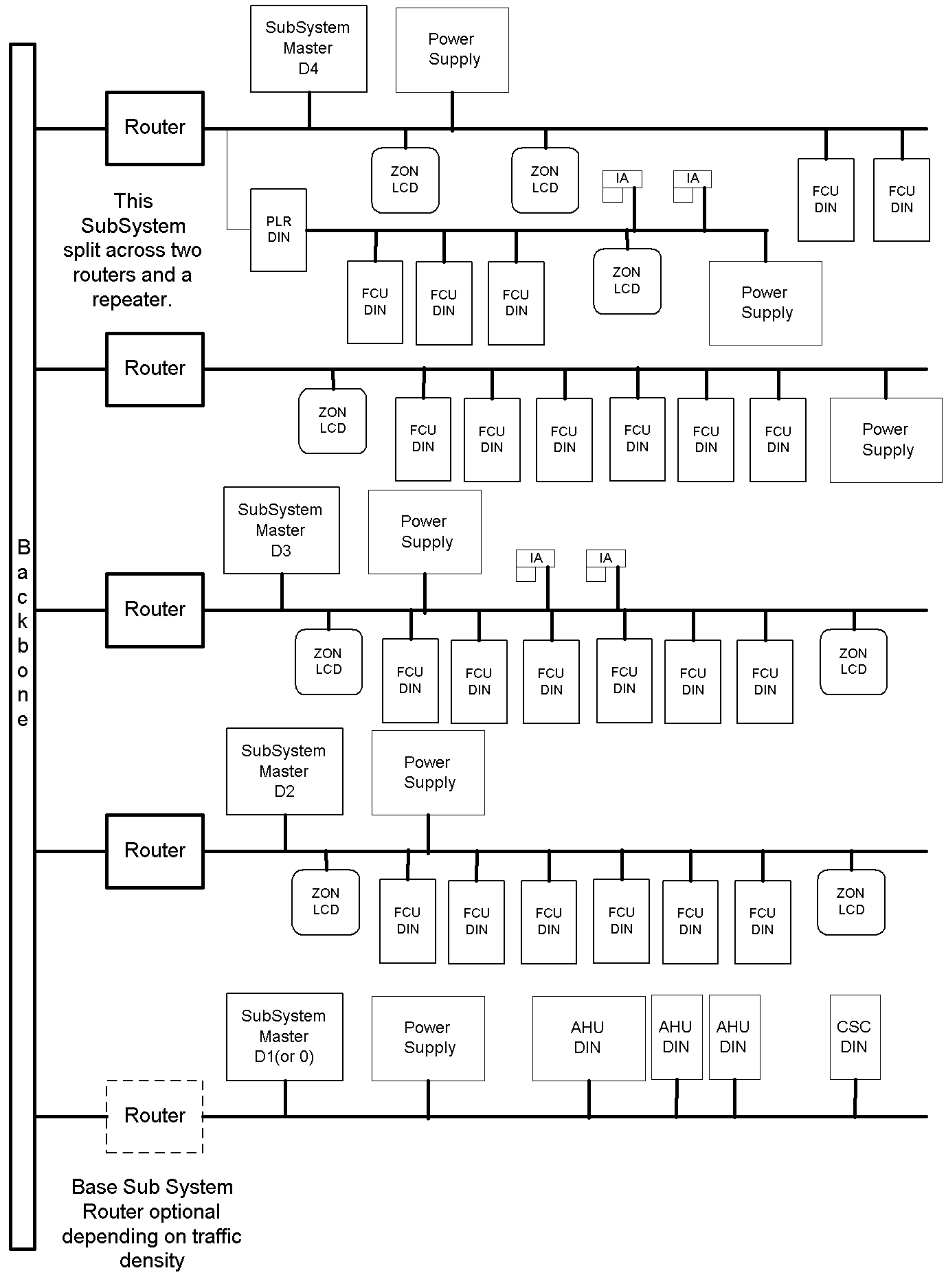Multiple Domain Systems
The SeaChange Plug and Play system has been extended to allow multiple domains, this
allows the previous limit for 200 Zones to now be extended to 1600 Zones. Each Domain uses
30 subnets and within this set of subnets a mixture of product types can be registered
depending upon the type of System Master used.
| |
Floor Controller |
Boiler |
AHU |
| Zones/Fan Coils |
200 |
100 |
80 |
| AHU |
10 |
50 |
40 |
| Sec Heat sources |
10 |
20 |
5 |
| Sec Cool sources |
10 |
20 |
5 |
| Monitor nodes |
10 |
25 |
5 |
| SLT |
4 |
8 |
4 |
| Router |
4 |
0 |
5 |
SubSystems
Each SubSystem has it's own local System Master (SSM) which must be located on the sub
system side of the router. The routers block local SubSystem traffic from propagating on
to the back bone. The local traffic consists of all Zone to Actuator, Zone to Fan Coil
messages, thus Fan Coils can only be supervised within their local SubSystem.
Only SubSystem masters which have version 4a code may be used in SubSystems other than
domain zero (base SubSystem). Boiler and AHU SSM's will be produced as the need arises, in
the meantime they can only be used on the base SubSystem.
Domain Numbers
The SubSystems are given domain numbers, which must be setup on the SSM (floor
controller) using a config variable DOMN. This must be done before any modules are
registered to the SSM. The domain number can be set between 0 and 8. The Controller
defaults to Domain one. Selecting Domain zero forces the controller to work in a single
domain to provide compatibility for pre version 4 modules.

Demand messages
Heat source (HTSC), cool source (CLSC) and occupation destinations (OCDS) now have a
domain associated with them. These messages remain local if the destination controller is
registered to the same SubSystem, otherwise the message is sent on the global domain and
the destination can be on any of the SubSystems. The links can be set up by registering
the Zone to the Heat source as for a single domain system, the domain addresses will be
set automatically, alternatively they may be setup using configuration parameters, the
domain is represented as the thousand digit on the parameter. e.g. 1001 source 1 on domain
1, 6052 source 52 on domain 6.
Registration
Each SubSystem can be regisistered independantly, if it is helpful to register
SubSystems in parallel then the easiest method is to temporarily disconnect the router
from the backbone. The SubSystem nodes can then be registered and all local links setup.
The service pin on the router should be pressed at this time and the SSM will allocate
adresses to the router and set it's mode correctly. Multiple routers can be used within a
sub system, local network traffic will be constrained within each segment, this might be
useful when there are a large number of relatively small floors.
When making changes to the system or setting registration links between SubSystems then
it is necessary to have the whole system on line, in this situation it is important that
only one registration master is active at any time, this is acheived by a new registration
mode. Select the SSM you wish to use in the normal way by setting it into config mode, if
you do not wish to set HTSC, CLSC links to the system master, press the 'select' button.
This will prevent these registration links being set up and will also broadcast to all
other SSM's that they should ignore registration messages until they are put into config
mode. This registration master mode is indicated by the status led flashing amber/red.
Config mode or Registration Master mode will automatically time out 30 minutes after the
last Registration message is received. Putting any System Master into configuration will
clear all other System Masters out of config mode and Registration Master mode. Putting
any other node into config mode will automatically change the System Master which is in
Config Mode to Registration Master mode.
Module Requirements
In order to operate correctly on a SubSystem all main modules must be version 4
software, main modules are Zones, Fan Coils, DHW, AHU main controller, Secondary Boiler,
HSC, CSC. All existing modules may be used on the base SubSystem which may be single
domain during the transistion period. Version 4 modules are fully backward compatible and
will be used for all projects as the code is released.
Sub modules, actuators, ahu sub modules, boiler sub modules, PCOs do not need to be
upgraded.
Products based on the 3120 processor need version 4 code which adds in support for a
second domain.
Time Syncronisation
Systems with multiple System Masters have multiple Real Time clocks, the network is
organised such that the clock updates are broadcast globally, so that all System Masters
receive all time updates and time broadcasts from other System Masters. The System Master
in the lowest numbered domain will undertake to be time master, if this controller fails
the next highest numbered master will take over broadcasting the time signals. This method
provides automatic syncronisation and full redundancy.
| 